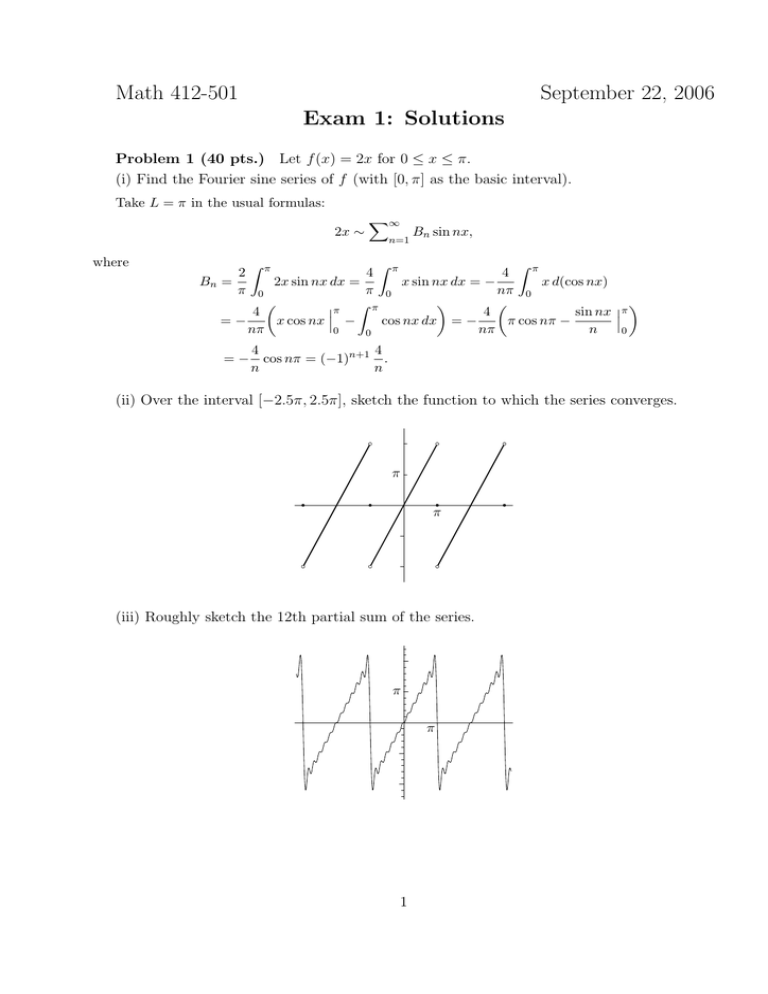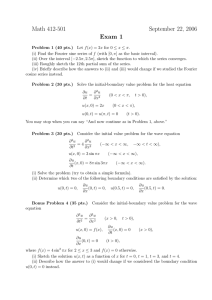Math 412-501 September 22, 2006 Exam 1: Solutions
advertisement

Math 412-501 September 22, 2006 Exam 1: Solutions Problem 1 (40 pts.) Let f (x) = 2x for 0 ≤ x ≤ π. (i) Find the Fourier sine series of f (with [0, π] as the basic interval). Take L = π in the usual formulas: 2x ∼ where X∞ n=1 Bn sin nx, Z Z π 4 π 4 2x sin nx dx = x sin nx dx = − x d(cos nx) π 0 nπ 0 0 π Z π 4 sin nx π 4 cos nx dx = − x cos nx − π cos nπ − =− nπ nπ n 0 0 0 2 Bn = π Z π 4 4 = − cos nπ = (−1)n+1 . n n (ii) Over the interval [−2.5π, 2.5π], sketch the function to which the series converges. π π (iii) Roughly sketch the 12th partial sum of the series. π π 1 (iv) Briefly describe how the answers to (ii) and (iii) would change if we studied the Fourier cosine series instead. The Fourier cosine series converges to the even 2π-periodic extension of f . This extension is continuous, so there is no Gibbs phenomenon in the partial sums. Problem 2 (30 pts.) Solve the initial-boundary value problem for the heat equation ∂2u ∂u = ∂t ∂x2 (0 < x < π, u(x, 0) = 2x t > 0), (0 < x < π), u(0, t) = u(π, t) = 0 (t > 0). You may stop when you can say “And now continue as in Problem 1, above.” First look for solutions with separated variables: u(x, t) = φ(x)G(t). Substituting this into the equation, we obtain that G′ φ′′ = = −λ = const. G φ Hence G ′ = −λG and φ′′ = −λφ. The boundary conditions are satisfied provided φ(0) = φ(π) = 0. The eigenvalue problem φ′′ = −λφ, φ(0) = φ(π) = 0 has eigenvalues λn = n2 , n = 1, 2, . . . . The corresponding eigenfunctions are φn (x) = sin nx. Further, the general solution of the equation G ′ = −λG is G(t) = ce−λt , where c is an arbitrary constant. 2 Therefore the functions u(x, t) = e−n t sin nx, n = 1, 2, . . . , are solutions of the boundary value problem. We are looking for the solution of the initial-boundary value problem as a superposition of solutions with separated variables: X∞ 2 bn e−n t sin nx. u(x, t) = n=1 The initial condition is satisfied if 2x = X∞ n=1 bn sin nx for 0 < x < π. Hence bn are coefficients of the Fourier sine series of the function f (x) = 2x on the interval [0, π]. It remains to use the solution of Problem 1(i). Problem 3 (30 pts.) Consider the initial value problem for the wave equation ∂2u ∂2u = 4 ∂t2 ∂x2 (−∞ < x < ∞, u(x, 0) = 3 sin πx −∞ < t < ∞), (−∞ < x < ∞), ∂u (x, 0) = 8π sin 3πx ∂t (−∞ < x < ∞). 2 (i) Solve the problem (try to obtain a simple formula). Let f (x) = 3 sin πx and g(x) = 8π sin 3πx, x ∈ R. According to d’Alembert’s formula, the solution is u(x, t) = 1 f (x − 2t) + f (x + 2t) + G(x + 2t) − G(x − 2t) , 2 where G is an arbitrary anti-derivative of the function g/2. We can take G(x) = − 43 cos 3πx. Then 4 4 1 u(x, t) = 3 sin π(x − 2t) + 3 sin π(x + 2t) − cos 3π(x + 2t) + cos 3π(x − 2t) 2 3 3 = 3 cos 2πt · sin πx + 4 sin 6πt · sin 3πx. 3 (ii) Determine which two of the following boundary conditions are satisfied by the solution: u(0, t) = 0, ∂u (0, t) = 0, ∂x u(0.5, t) = 0, ∂u (0.5, t) = 0. ∂x The solution satisfies the boundary conditions u(0, t) = 0 and ∂u ∂x (0.5, t) = 0, which can be verified directly. Another way to show this is to observe that the initial data f (x) = 3 sin πx and g(x) = 8π sin 3πx are odd around 0 and even around 0.5, that is, f (−x) = −f (x), g(−x) = −g(x), f (0.5+x) = f (0.5 − x), and g(0.5 + x) = g(0.5 − x) for all x ∈ R. This implies that the solution u(x, t) is odd around 0 and even around 0.5 as a function of x, which, in turn, implies the two boundary conditions. Bonus Problem 4 (35 pts.) equation Consider the initial-boundary value problem for the wave ∂ 2u ∂ 2u = ∂t2 ∂x2 u(x, 0) = f (x), ∂u (0, t) = 0 ∂x (x > 0, t > 0), ∂u (x, 0) = 0 ∂t (x > 0), (t > 0), where f (x) = 4 sin2 πx for 2 ≤ x ≤ 3 and f (x) = 0 otherwise. (i) Sketch the solution u(x, t) as a function of x for t = 0, t = 1, t = 3, and t = 4. The solution u(x, t) can be extended to a solution in the whole plane that satisfies the initial conditions u(x, 0) = F (x) and ∂u ∂t (x, 0) = 0, where the function F : R → R is the even extension of f . By d’Alembert’s formula, u(x, t) = 12 (F (x − t) + F (x + t)). This representation allows one to easily sketch u(x, t) as a function of x for any t ≥ 0 outside intervals (0, 1/2) and (2, 3). At t = 0, there is a single pulse localized on the interval (2, 3). It is divided into two identical pulses of the same shape and half the amplitude which start moving in opposite directions at unit speed. At t = 1/2, the two pulses become separated. At t = 2, the pulse travelling to the left reaches the end of the interval. Between t = 2 and t = 3 the pulse is being reflected from the boundary. The reflection is completed by t = 3 when the pulse assumes the same shape as at t = 2. Then it starts travelling to the right at unit speed. 3 u(x, t) t=0 1 1 x 1 x 1 x 1 x 1 x u(x, t) t=1 1 u(x, t) t=2 1 u(x, t) t = 2.5 1 u(x, t) t=3 1 4 u(x, t) t=4 1 x 1 (ii) Describe how the answer to (i) would change if we considered the boundary condition u(0, t) = 0 instead. In this case, the solution is u(x, t) = 12 (F − (x − t) + F − (x + t)), where F − is the odd extension of the function f to the real line. The two solutions coincide for 0 ≤ t ≤ 2. Since t = 2, the left pulse looks differently. In particular, after reflection from the boundary it turns upside down. u(x, t) t = 2.5 1 1 x 1 x 1 x u(x, t) 1 t=3 u(x, t) 1 t=4 5





